 Next
Next
- The population of those aged 65 or older was 24.31 million as of October 1, 2003, among which 10.26 million were male, exceeding 10 million for the first time.
The percentage of the elderly to the total population was 19.0%. Of the total elderly population, the younger-elderly population (65-74) was 13.76 million, while the older-elderly population (75 or older) was 10.55 million. (Table 1-1-1)
The national population aged 100 or older has exceeded 20,000 as of September 2003, doubling in only five years.
- It is estimated that the elderly population will continue to increase rapidly until 2020 and stabilize thereafter. On the other hand, while the total population is turning to a decrease, the percentage of the elderly is estimated to continue increasing, and to reach 26.0% in 2015 and 35.7% in 2050. (Chart 1-1-3)
Table 1-1-1. Status of Aging
| Oct.1, 2003 | Oct.1, 2002 | Number of increase |
Rate of increase |
||||||
|---|---|---|---|---|---|---|---|---|---|
| Total | Male | Female | Total | Male | Female | (Total) | (Total) | ||
| Population (10 thousand) |
Total population | 12,762 | 6,230 | 6,532 | 12,744 | 6,225 | 6,518 | 18 | 0.1 |
| (Ratio of men to women) 95.4 | (Ratio of men to women) 95.5 | ||||||||
| Elderly population (65 and older) | 2,431 | 1,026 | 1,405 | 2,363 | 996 | 1,367 | 68 | 2.9 | |
| (Ratio of men to women) 73.0 | (Ratio of men to women) 72.9 | ||||||||
| Younger-elderly population (65-74) | 1,376 | 641 | 735 | 1,359 | 632 | 726 | 17 | 1.3 | |
| (Ratio of men to women) 87.2 | (Ratio of men to women) 87.1 | ||||||||
| Older-elderly population (75 and older) | 1,055 | 385 | 670 | 1,004 | 364 | 641 | 51 | 5.1 | |
| (Ratio of men to women) 57.5 | (Ratio of men to women) 56.8 | ||||||||
| Working population (15-64) | 8,540 | 4,287 | 4,253 | 8,571 | 4,302 | 4,269 | -31 | -0.4 | |
| (Ratio of men to women) 100.8 | (Ratio of men to women) 100.8 | ||||||||
| Child population (0-14) | 1,791 | 918 | 873 | 1,810 | 928 | 883 | -19 | -1.0 | |
| (Ratio of men to women) 105.1 | (Ratio of men to women) 105.1 | ||||||||
| Percentage distribution | Total population | 100.0 | 100.0 | 100.0 | 100.0 | 100.0 | 100.0 | - | - |
| Elderly population (Percentage of elderly) | 19.0 | 16.5 | 21.5 | 18.5 | 16.0 | 21.0 | - | - | |
| Younger-elderly population | 10.8 | 10.3 | 11.3 | 10.7 | 10.2 | 11.1 | - | - | |
| Older-elderly population | 8.3 | 6.2 | 10.3 | 7.9 | 5.8 | 9.8 | - | - | |
| Working population | 66.9 | 68.8 | 65.1 | 67.3 | 69.1 | 65.5 | - | - | |
| Child population | 14.0 | 14.7 | 13.4 | 14.2 | 14.9 | 13.5 | - | - | |
| Source: | Statistics Bureau, Ministry of Internal Affairs and Communications, "Population Projections for Japan" (As of October 1 each year) |
| Note: | "Ratio of men to women" refers to the population ratio of males to 100 females. |
Chart 1-1-3. Changes in Aging and Population Projections
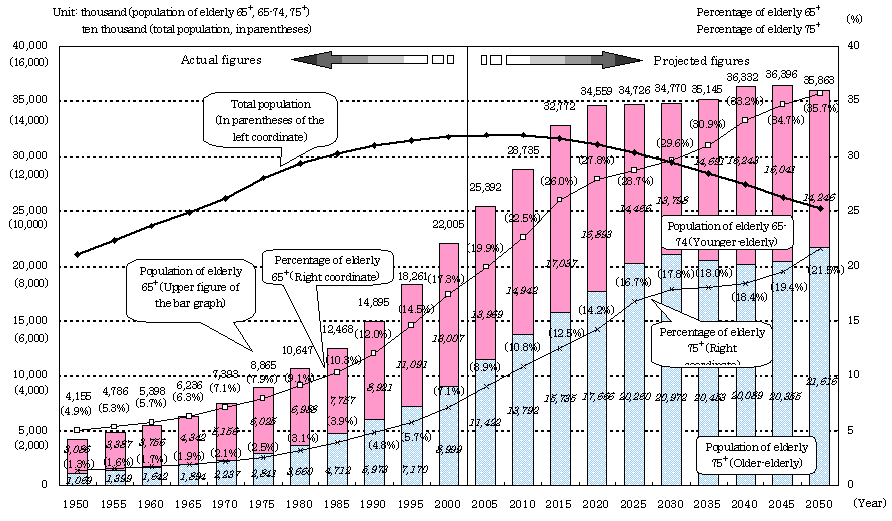
| Source: | Up to 2000: Ministry of Internal Affairs and Communications, "Population Census of Japan" After 2005: National Institute of Population and Social Security Research, "Population Projections for Japan," January 2002 |
| Note: | Regarding Okinawa in 1955, the population of persons 70+, 23,328, was divided into the age groups 70-74 and 75 or older, based on the ratio of the population 75+ to the population 70+ in the former and later years. |
- The percentage of the elderly by prefecture is low in the three biggest urban areas and high in the other areas. Shimane Prefecture is the highest, with 24.8%, and Saitama Prefecture is the lowest, with 12.8% as of 2000. It is estimated that the percentage will grow in every prefecture in the future. According to the projection, the highest will be 35.4% in Akita Prefecture, and even the lowest will reach 24.0% in Okinawa Prefecture in 2025. (Table 1-1-4)
Table 1-1-4. Trends in Percentage of the Elderly by Prefecture
|
|
| Source: | Year 1975, 2000: Ministry of Internal Affairs and Communications, "Population Census of Japan" Year 2025: National Institute of Population and Social Security Research, "Population Projections by Prefecture," March 2002 |
- Municipal distribution by the percentage of the elderly mainly concentrated on 10% or more but less than 15% in 1980 and 1985; in 2000, however, 20% or more but less than 25% was the highest with a wider distribution.
- Since World War II, average life expectancy has drastically enhanced in Japan; in 2002, it was 78.32 years for men and 85.23 years for women. As to average life expectancy at the age of 65, it was 17.96 years for men and 22.96 years for women, which shows that both old age periods are getting longer. (Chart 1-1-8)
Chart 1-1-8. Trends in Life Expectancy at Birth and Average Life Expectancy at the Age of 65
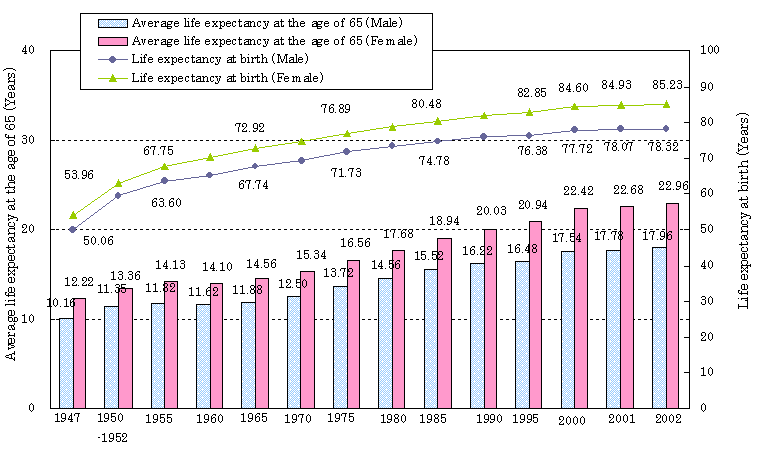
| Source: | Ministry of Health, Labour and Welfare, "Life Table (Complete Life Table)" "Abridged Life Table" for 2001 and 2002 |
- Regarding the status of birth, the total fertility rate has rapidly declined since the postwar baby boom: 2.22 in 1956, 1.91 in 1975, falling below 2.00, and in 2002 reaching the lowest at 1.32. (Chart 1-1-9)
Chart 1-1-9. Trends in Number of Births and Total Fertility Rate
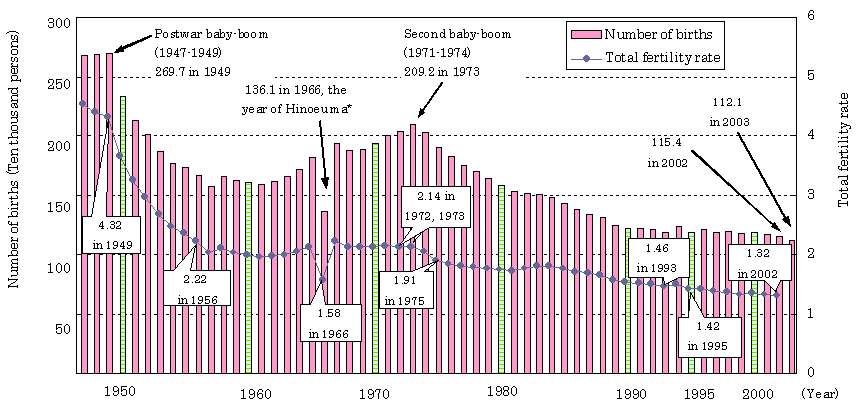
| Source: | Ministry of Health, Labour and Welfare, "Vital Statistics" |
| Note: | 1. The number of births in 2003 is an estimated figure. 2. Okinawa Prefecture is excluded in data before 1972. |
- The labour force population aged 65 or older was 4.89 million in 2003, which is 7.3% of the total labour force population. As the workforce population turns to a decline in the future, their aging will probably grow even faster. (Chart 1-1-14)
Chart 1-1-14. Trends and Future Prospects of Labour Force Population
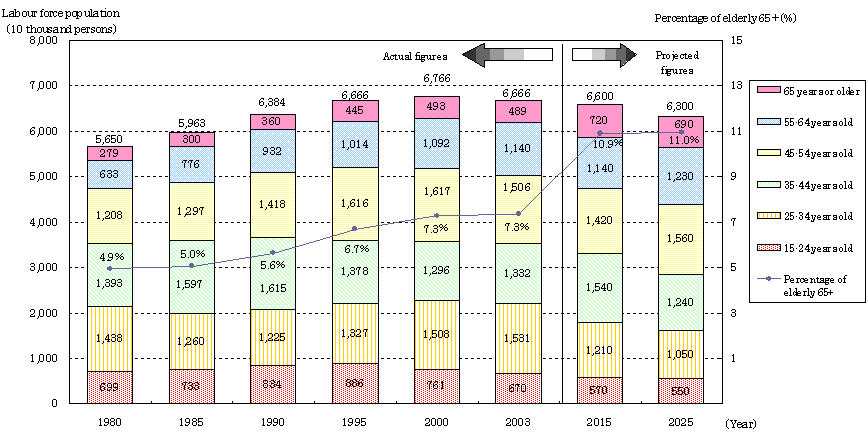
| Source: | Up to 2003: Ministry of Internal Affairs and Communications, "Labour Force Survey" After 2015: Based on the projection prepared by Ministry of Health, Labour and Welfare |
- Social security benefits in pension, medical health and welfare amounted to 81.4007 trillion yen in 2001, 22.0% of the total national income, which was 5.8% in 1970. The breakdown of the elderly-related benefit expenditure shows that pension insurance benefits amounted to 40.6178 trillion yen, accounting for slightly less than three-fourths of the total. (Chart 1-1-15)
Chart 1-1-15. Trends in Social Security Benefits
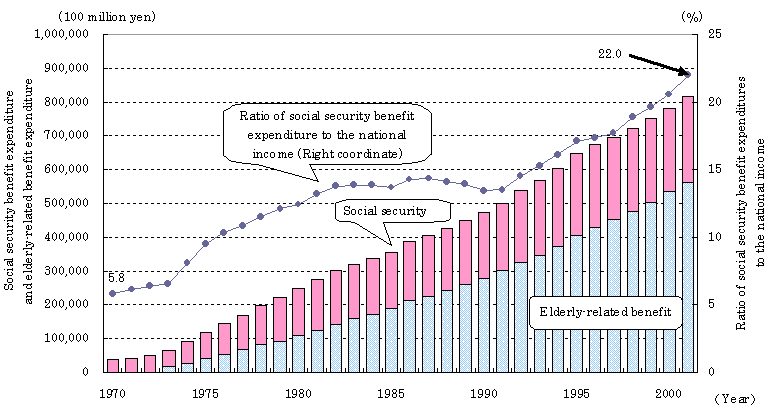
| Source: | National Institute of Population and Social Security Research, "Social Security Benefit Expenditure" |
| Note: | Elderly-related benefit expenditure includes the benefits of pension insurance, health and medical service, old-age welfare, and old-age continued employment. It has been counted since 1973. |
- The percentage of the elderly in the world is expected to rise to 15.9% in 2050 from 6.9% in 2000. Aging is estimated to grow rapidly during half the century hereafter. (Table 1-1-17)
- In comparison with the percentage of the elderly in developed countries, Japan was in the lower-rankings until the 1980s, in the middle in the 1990s, and is expected to be the highest in the early 21st century. (Chart 1-1-18)
Table 1-1-17. Trends in World Population
| Year | 1950 | 2000 | 2050 |
|---|---|---|---|
| Total population | 2,518,629 | 6,070,581 | 8,918,724 |
| Population aged 65+ | 130,865 | 419,197 | 1,418,742 |
| Developed regions | 64,034 | 170,744 | 315,507 |
| Developing regions | 66,831 | 248,453 | 1,103,234 |
| Percentage of those aged 65+ | 5.2 | 6.9 | 15.9 |
| Developed regions | 7.9 | 14.3 | 25.9 |
| Developing regions | 3.9 | 5.1 | 14.3 |
| Life expectancy at birth (Male) | 45.2 | 63.3 | 72.0 |
| Life expectancy at birth (Female) | 47.9 | 67.6 | 76.7 |
| Total fertility rate | 5.0 | 2.7 | 2.0 |
| Source: | UN, "World Population Prospects," The 2002 Revision |
| Note: | 1. Life expectancy at birth and total fertility rate are 1950-1955, 1995-2000, and 2045-2050. 2. Developed regions include Europe, North America, Japan, Australia, and New Zealand. Developing regions include areas other than developed regions. |
Chart 1-1-18. Trends in Percentage of the Elderly in the World
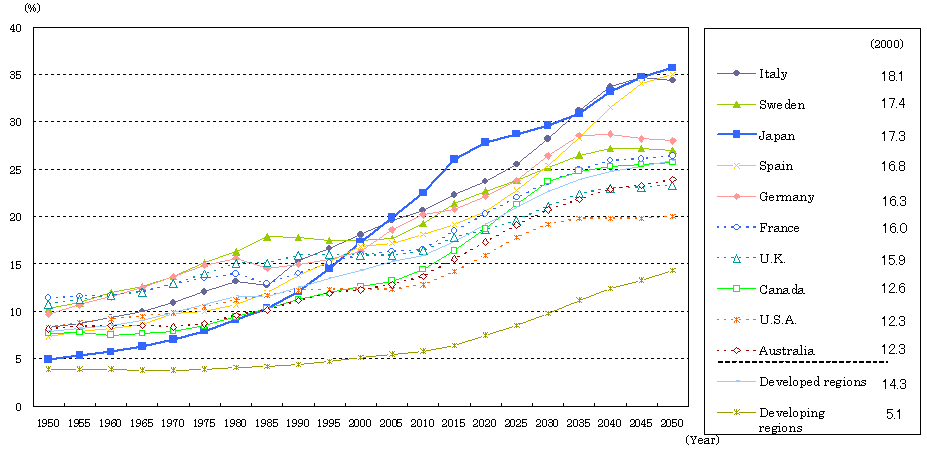
| Source: | UN, "World Population Prospects," The 2002 Revision Data for Japan is based on "National Census of Japan" (Ministry of Internal Affairs and Communications) and "Population Projection for Japan" (National Institute of Population and Social Security Research, January 2002). |
| Note: | Developed regions include Europe, North America, Japan, Australia, and New Zealand. Developing regions include areas other than developed regions. |
Top Page > Annual Report on the Aging Society > Annual Report:2004